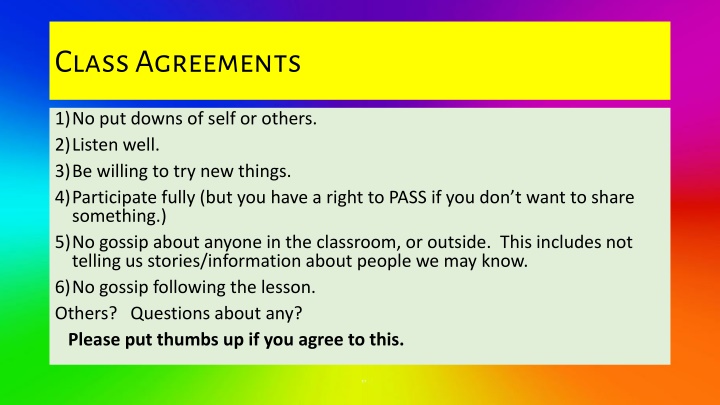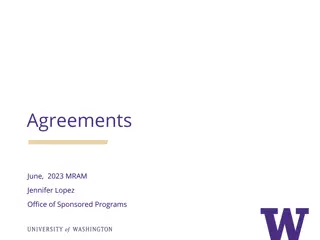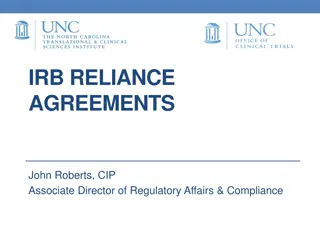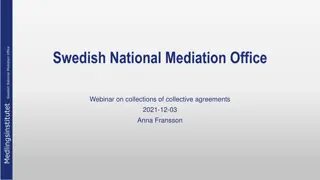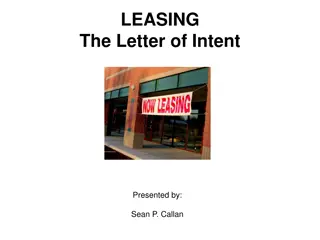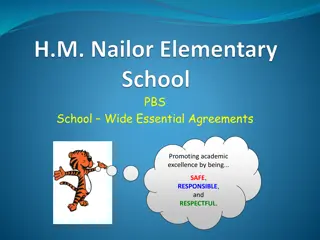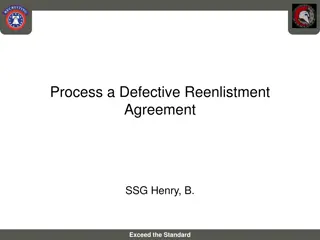Class Agreements
In this lesson, students will delve into the world of emotions, learning to recognize and understand them through various activities. From setting class agreements to a musical emotion quiz, the lesson aims to help students explore the main emotions we all experience and how to express them effectively. Through discussions, activities, and music, students will have the opportunity to connect with their feelings and those of others.
Download Presentation

Please find below an Image/Link to download the presentation.
The content on the website is provided AS IS for your information and personal use only. It may not be sold, licensed, or shared on other websites without obtaining consent from the author.If you encounter any issues during the download, it is possible that the publisher has removed the file from their server.
You are allowed to download the files provided on this website for personal or commercial use, subject to the condition that they are used lawfully. All files are the property of their respective owners.
The content on the website is provided AS IS for your information and personal use only. It may not be sold, licensed, or shared on other websites without obtaining consent from the author.
E N D
Presentation Transcript
Class Agreements 1)No put downs of self or others. 2)Listen well. 3)Be willing to try new things. 4)Participate fully (but you have a right to PASS if you don t want to share something.) 5)No gossip about anyone in the classroom, or outside. This includes not telling us stories/information about people we may know. 6)No gossip following the lesson. Others? Questions about any? Please put thumbs up if you agree to this.
This terms topic is called.. This term s topic is called.. How do I deal with my emotions? How do I deal with my emotions? Now complete your RAG sheet.
Learning objectives: In today s lesson, we are going to explore What are emotions? What are the main emotions we all feel? How can we recognise them in ourselves and others?
What are emotions? What are emotions? What are they? Dictionary definition = strong inner feelings (as anger, love, joy, or fear) often accompanied by a physical reaction ( for example She flushed with emotion. One minute challenge: Draw all the emoji's (that express emotions) that you know and write the emotion beneath them (e.g. the poo emoji doesn t count!) Count your emojis. Stand up. The teacher will start counting from 1. When you hear the number of emojis you have sit down. The last person standing is the winner!
Here are some possible answers Here are some possible answers relaxed happy cheerful scared worried silly
What are the main emotions that we all feel?
Although there are many emojis, It is widely accepted that these could be reduced To SIX MAIN HUMAN EMOTIONS FELT BY ALL. What do you think the six are? They are.. ANGER SADNESS FEAR JOY/HAPPINESS DISGUST SURPRISE
Musical Emotion Quiz ! Task 1 Musical Emotion Quiz ! Task 1 Look at your emotion quiz card. On it are THE SIX MAIN EMOTIONS. 1) You are going to listen to six pieces of music (titles listed below.) At the end of each piece of music, write it s number under the emotion that you think it communicates. 2) Try to write on the dotted line why you think it communicates this emotion (use the musical elements list to help you.) JOY FEAR ANGER E.g. Number 1 because SADNESS DISGUST SURPRISE Musical Elements: TEMPO (how fast or slow is the music?) DYNAMICS (how loud is the music?) PITCH (are the notes high or low?) INSTRUMENTATION (what instruments you can hear playing / what sort of thing are they playing?) HARMONY (do the notes sound nice together or do they clash?)
Musical Emotion Quiz ! Task 1 Musical Emotion Quiz ! Task 1 We all have different responses to music and other media but there are certain things about each piece of music that expressed one of the main emotions. See if you agree JOY Piece 3 FEAR Piece 1 ANGER Piece 2 SADNESS Piece 5 DISGUST Piece 6 SURPRISE Piece 4
Task 2 Now spend some time drawing shapes and Task 2 Now spend some time drawing shapes and colours that you think represent these emotions in colours that you think represent these emotions in an abstract way. an abstract way. JOY FEAR ANGER SADNESS DISGUST SURPRISE Let s compare! Let s compare!
How can we recognise emotions in others? Discuss. We recognise others emotions through: Their facial expressions (how their face has changed because of the emotion.) Their body language (how their body position/movements have changed because of the emotion.) Their tone of voice (how their voice has changed because of the emotion.)
Drama Game Drama Game The Emotion Gallery The Emotion Gallery Imagine that a gallery has been opened to help young children identify the six different emotions through facial expressions and body language. Create a frozen body/facial position for each emotion, you can make a note of the body positions if you forget. Now let s guess each other s emotions! First in pairs then as a class! Optional extra work in pairs. Person 1 sculpts Person 2s body position to show one of the six emotions. Then the group that aren t sculpted can guess the emotions. Swap. Check everyone consents to this game (vote as a class.) Anyone unhappy could be the sculptor only.
To explore emotions, we are going to play another To explore emotions, we are going to play another drama game called drama game called Manner of the Adverb Manner of the Adverb. But first, what is an adverb? first, what is an adverb? . But An adverb describes the way a VERB (doing word) is performed e.g. she An adverb describes the way a VERB (doing word) is performed e.g. she closed the door angrily. closed the door angrily. But first! Challenge But first! Challenge turn these emotions into adverbs. turn these emotions into adverbs. JOY FEAR ANGER Angrily Joyfully Fearfully SAD DISGUST Disgustedly SURPRISE Surprisedly Sadly
Drama Game Drama Game Manner of the Adverb Manner of the Adverb (NB: an adverb describes how a verb is performed.) (NB: an adverb describes how a verb is performed.) Person A chooses an action they would like to see Person B do (e.g. drinking a cup of tea.) Person B chooses one of the six emotions e.g. anger. Then acts out person As command but showing this emotion e.g. Person B drinks the tea angrily. Person A has to guess what emotion person B is feeling. Swap over. Then do some as a whole class!
Drama Game Drama Game Voicing our Emotions. Voicing our Emotions. Remember emotions can also be recognised by someone s tone of voice. So we are going to play a drama game now to explore this! In pairs Perform this simple script but each choose one of the six emotions and say/perform it in this way. Once you have done it, guess which emotion each person chose. Now repeat with a different partner/and emotion. (Stand and walk towards each other.) Person 1: Good morning, how are you? Person 2: Hello, I m fine, I hope you re well. (Now walk past each other.)
How can we recognise emotions in ourselves? Discuss. It can actually be more tricky to recognise what emotion/s am I feeling right now? A famous Disney film, called Inside Out, was created to help people do this. Let s watch the opening and look out for how the Director shows what the main emotions are. https://youtube.com/watch?v=x__NgnMBHV0&feature=sh are
In the film, Inside Out, cartoon characters have been created to demonstrate the different human emotions (the Director only included five due to the story line.) Task 3 On the bookmark strip, draw your own six cartoon characters for each emotion. Use the tables you completed earlier to help (with shapes/colour etc.) JOY FEAR ANGER SADNESS DISGUST SURPRISE
Our body tells us how we feel Emotions begin in the brain with a thought, then ripple down through the body. Different emotions, create different effects in the body. Although we are all different, we may experience similar bodily sensations when we feel something. Emotions in the Body map created by scientists in Finland after interviewing a large section of people they created this map showing we all feel things in similar ways.
Challenge look at the body sensations below. Try to link them to each of the six emotions. Now write them beneath your six characters. You can use them as many times as you like and each emotion will probably have more than one bodily sensation. Please do add your own if you wish. Body sensations: I feel hot My shoulders tense I clench my fists I get a headache I shake My stomach hurts/clenches My jaw tenses My mouth/throat becomes dry My heart beats faster I cry My chest hurts I become jumpy I feel warm My shoulders relax My mind races I smile My body tingles I feel very awake Discuss and compare as a class.
We have started to create a bookmark to help you deal with your emotions. We are going to add to it each week, so for now please put it in your folder, don t take it home.
Homework challenge this week, try to pause when you feel a strong emotion, feel where it is in your body. Then try to name the emotion. Notice what happens when you do this, does the emotion become stronger or calmer? Important point you can actually experience a mixture of emotions at the same time e.g. happy to break up for summer, sad you won t see your friends.
Learning Review: 1) What is an emotion? 2) What are the six main emotions? 3) How can we recognise them in others? 4) How can we recognise them in ourselves?
Learning Review: 1) What is an emotion? A strong inner feeling that affects our body. What are the six main emotions? Anger, joy, fear, surprise, disgust, sadness. How can we recognise them in others? Facial expressions, body language, tone of voice. How can we recognise them in ourselves? Our bodily sensations tell us how we feel. Remember - we can have a mixture of emotions at the same time. 2) 3) 4)
